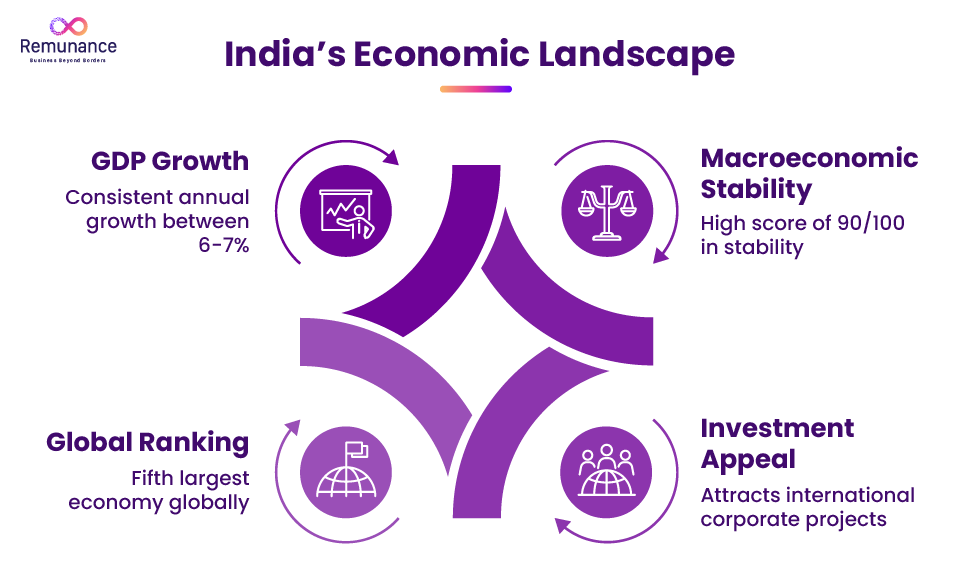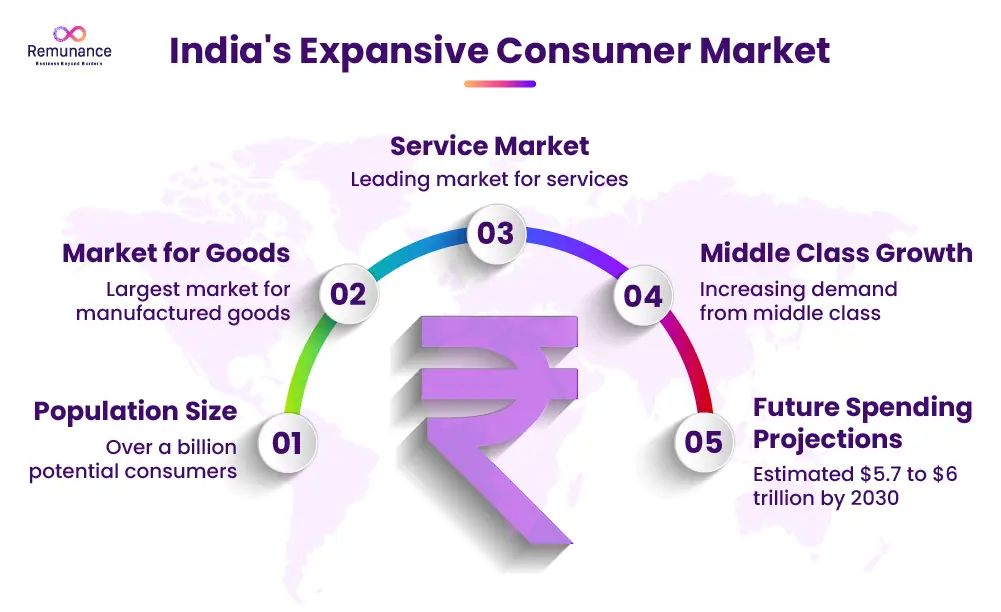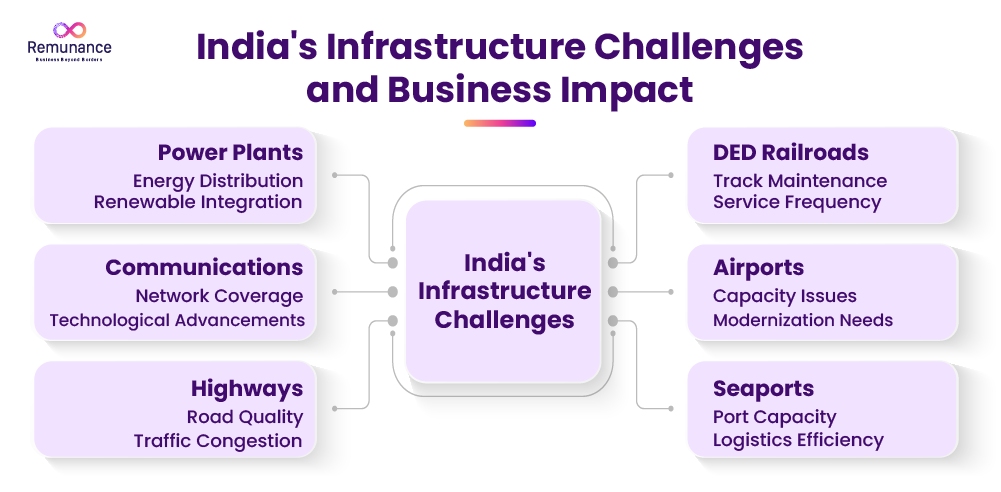Summary
India’s dynamic business environment offers both opportunities and challenges. Advantages include a stable, robust economy with consistent GDP growth, a massive consumer market, and rapid digital innovation. However, businesses may face challenges such as complex compliance procedures, high tariffs, fragmented markets, and infrastructure issues. Success requires strategic planning, cultural understanding, and adaptability.
India’s business arena mixes promise with complexity. A stable economy, tech innovation, and a massive consumer market offer lucrative prospects. Challenges such as strict rules, high tariffs, split markets, and weak infrastructure need strong and flexible strategies for success.
India never gets old in terms of its dynamic business environment and rich culture. India offers a challenging yet promising market. It is the largest democracy in the world and one of the fastest-growing economies. Doing business in India can feel like running a surprising marathon without shoes.
The benefits are big for those who have the right mindset, enjoy negotiating, and like a good cup of strong chai.
In this guide, we shall discuss the benefits and drawbacks of joining the Indian market. We will look at India’s economic stability, its growth, and digital skills. These factors draw in global investors. We will balance that picture by looking at obstacles. These include infrastructure problems and the bureaucratic paths you need to navigate.
Advantages and Benefits of Doing Business in India
A Stable and Robust Economy

In recent years, India’s economy has shown a fantastic increase. India ranks as the fifth biggest economy in the world, with an annual GDP growth routinely falling between 6 and 7%. A steady macroeconomic foundation supports this strong increase. With a remarkable 90 out of 100 in macroeconomic stability, India ranks 41st out of 141 economies overall, according to the World Economic Forum’s Global Competitiveness Index.
This stability gives international investors a steady foundation for starting corporate projects. Think of a long-term investment like building a strong foundation, not a weak sandcastle.
Progressive Business Reforms
The Indian government has carried out major corporate changes in order to draw foreign money. Recent laws have changed. They raised foreign stock limits in sectors like insurance and the military. As a result, foreign direct investment (FDI) restrictions are now less strict. This reformative attitude has raised India’s profile on world business indices.
The World Bank’s Doing Business assessment shows that India ranks 63rd now. This is a 14-point increase. The steady improvement shows a strong desire to change the investment environment. This is true, even if the data feels like a rollercoaster ride. “India’s rise in the Doing Business rankings is a great achievement,” said Junaid Ahmad, World Bank Country Director in India. This reflects actual, sound change, not just bureaucratic rhetoric.
Digital Competitiveness and Technological Innovation
India is rightfully known as a powerhouse in technological innovation. Indian businesses in telecom, IT, drugs, textiles, and engineering often match or even surpass foreign firms. India is seen as a key player in tech innovation. It stands alongside giants like the United States and China.
The digital revolution in India speeds up company processes. It also opens new chances for growth and cooperation. For businesses, entering the Indian market means thriving in a space that fosters innovation and creativity. It’s more than just getting by. Your next great tech innovation is a brainstorming session away, given fast digitalization.
A Massive and Expanding Consumer Market

India’s huge consumer market is the main draw for businesses. India has over a billion people. It has the largest market for manufactured goods and services in the world. The growing middle class is boosting demand for luxury cars and high-tech gadgets. The World Economic Forum estimates that by 2030, India’s total spending will reach $5.7 to $6 trillion.
View the market as a big canvas. It has room for new ideas, unique products, and creative business methods. Your company may just have blockbuster success if you can grab even a fraction of this market.
Disadvantages and Risks of Doing Business in India
The Indian market presents fantastic possibilities, but it also presents specific difficulties. A successful business in India needs more than a strong idea. It requires patience, smart planning, and the ability to handle complex situations. Even experienced entrepreneurs can feel overwhelmed by these challenges.
The Complexity of Compliance and Business Registration
Starting an Indian business is not for the timid. The procedure is still very difficult, even if it is improving in some areas. For instance, registering a business in India may cost 7.4% of the value of the property and need up to 68 days. In many OECD high-income countries, the process is usually far less costly and far faster.
Look at Mumbai, for example. In many developed countries, entrepreneurs must register a business. This involves ten steps, which is double the average of just five processes. This process takes longer—about 18 days compared to the OECD average of 9.2 days. It also needs a lot of patience and endurance. You might even wonder if you signed up for a marathon instead of starting a business.
High Tariffs and Protectionist Policies
India’s tariffs and protectionist policies are tough challenges for foreign investors. With India’s average imposed tariff among the highest among the G20 nations, imported goods are far more costly. This protectionist strategy aims to shield local businesses from foreign competition. However, it can make overseas companies feel like they’re climbing a financial Everest.
India has even raised import taxes in recent years in order to lessen the flood of less expensive foreign products. The nation’s trade policy is a mixed bag. On one hand, it aims to protect local businesses. On the other hand, it includes steps to encourage international investment. India’s choice to withdraw from significant trade deals such as the Regional Comprehensive Economic Partnership (RCEP) only accentuates the complexity and leaves investors continuously needing to adjust their plans.
A Vast, Diverse, and Fragmented Market
India’s market’s size is a two-edged blade. One could say it offers great promise. On the other hand, it presents a mix of regional, cultural, and legal differences. These can confuse even the most experienced entrepreneur.
Indian states might be as unique from one another as whole different nations are. Policies, languages, corporate behavior, and cultural quirks differ significantly. In the north, people mostly use Hindi. In the south, they often prefer English or their local languages for business. Because of language and cultural fragmentation, a one-size-fits-all solution is hardly ever effective. Instead, businesses must customize their plans for every area, therefore complicating market entrance.
It’s like a dinner party. One guest may want mild food, while another prefers hot. Each guest has different tastes. Managing these changes needs a strong understanding of local markets. It also requires a flexible approach to how consumers get involved and have control.
Infrastructure

India’s infrastructure still creates problems even with notable developments throughout the years. The nation is changing a lot, but there are still gaps in key areas. These include highways, railroads, airports, seaports, power plants, and communications. India covers over 3.2 million square kilometers. So, even small disturbances can greatly affect business activities.
Rising earnings, population growth, and urbanization are stressing current infrastructure more and more. The government is heavily funding infrastructure projects, but delays often happen. Progress can be slow. For companies depending on effective supply chains, these infrastructural issues may show up as longer lead times, higher expenses, and a significant amount of logistical problems.
Intellectual Property
For companies that depend on innovation and proprietary technology, protecting intellectual property (IP) in India can be a major concern. While India’s local IP laws are primarily aligned with those of the European Union and the United States, enforcement remains a significant challenge. Bureaucratic delays and lack of transparency can stretch IP disputes for years. This can test the patience of even the calmest innovator.
Businesses risk having their new ideas and tech stolen without quick IP protection. Any delay in implementing IP rights can be a costly loss at a time when knowledge moves at the speed of light.
Strategic Considerations for Doing Business in India
What, therefore, is required to thrive in a market this large and varied as India? The solution blends operational resilience, cultural awareness, and strategic planning. Before exploring the Indian corporate scene, consider these key features:
Do Your Homework
Doing extensive due diligence is absolutely necessary when opening a shop. Know the local cultural quirks, legal climate, and market conditions. Consult local experts for guidance on state rules and customer preferences. Simply said, avoid merely dipping your toes into the local waterways.
Prepare for Bureaucracy
Get ready for a bureaucratic journey if you don’t love paperwork and long negotiations. Registering a business in India may involve more steps and more waiting time than you’re used to. Patience isn’t just a virtue here; it’s a necessity. Think of it as a test of your endurance, like waiting for your favorite movie sequel that seems to take forever.
Customize Your Approach
India is not an island. Every state and occasionally even every city can have its own way of doing things. Customize your company plan to handle variances in consumer behavior, language, and culture. This might involve setting up tailored marketing campaigns. You could also adjust your offerings to meet local needs more effectively. Your biggest friends in this country are flexibility and customizing.
Leverage Digital Technologies
In a nation fast embracing digital transformation, technology is both a tool and a road map to success. Ensure your company matches the tech-savvy Indian consumers you want to serve. Use digital solutions to streamline operations. Also, tap into internet channels for market research. Digital competitiveness means more than just having an app. It involves building a flexible business model that can adapt to how consumers behave.
Develop Robust Risk Mitigation Strategies
Like every commercial endeavor, India is not unusual in terms of dangers. A strong risk management strategy helps you handle changing tariffs, tackle infrastructure issues, and protect intellectual property.
Think of joint ventures with nearby companies to distribute risks and take use of their existing networks. This cooperative approach might make all the difference between a rough start and a seamless market entrance.
Invest in Local Relationships
Business in India is often about relationships as much as it is about transactions. Trusting local partners, suppliers, and government officials can lead to smoother operations. Networking is important. It helps you build local relationships. You might find that opportunities arise faster than if you were a stranger.
Real-World Success Stories and Cautionary Tales
Success stories are common in the Indian market. International companies have thrived by adapting to local conditions. Businesses that have made investments in local talent welcomed digital innovation, and skillfully negotiated bureaucratic obstacles have typically found tremendous benefits. These companies show that problems are solvable with the correct approach.
There are, yet, also warning stories. Some businesses have faltered by undervaluing the complexity of the market. Ignoring local rules, not personalizing products, and skipping prep for delays can cause big problems later on. The key lesson is to approach India with hope and respect for its unique challenges.
It’s like driving a car without knowing where north is. You can’t start a software company without understanding local digital consumer behavior. Success in India often comes from blending local insights with global experience. This helps your company adapt well to the local market.
A Journey Worth Taking
India offers excellent business design web potential and unique problems. Its strong economy, smart reforms, tech innovation, and large customer base draw foreign investment. Success faces challenges like bureaucracy, high taxes, and fragmented markets. There are also issues with infrastructure and IP.
India’s business needs patience, strategy, and optimism. Change-seekers can reap significant rewards. Making a spicy curry. Handle it with care. Add the right components. Get ready for a taste explosion that can boost your company.
Are you ready for complexity before proceeding?
Could you handle a diversified market with exciting prospects and complex challenges? The Indian market may be your next big find. Bureaucratic delays and long registration times can be tough. But remember, every challenge is a chance to make progress.
The journey can be long and tough, but being part of one of the world’s busiest markets makes it worthwhile. To make this job easier, we offer Employer of Record services!
Conclusion – A Market That Demands Respect and Resilience
Entering the Indian market is like starting an adventure. Here, modern life meets history. Fast innovation clashes with deep-rooted bureaucracy.
What stands out?
India presents a delicious combination of possibility and difficulty. The nation is a potential frontier for companies all around, with consistent economic development, a positive change in business reforms, and a constantly growing consumer base. Still, without enough preparation, the hazards and challenges may readily exceed the benefits. Your company can succeed in this changing market. Use a mix of optimism, solid planning, and a willingness to adapt to local needs.
So, remember that success in India is mainly about balance, even if you’re eager to dive into one of the most exciting markets. Accept the stability, use the reforms, and get ready for the challenges. If not more so, you might easily find that the trip is as gratifying as the endpoint.
India’s business scene calls for both seasoned investors and new entrepreneurs. It provides growth and creativity. However, it can also bring some bureaucratic hassles to keep you alert. After all, without some surprises along the road, what would a decent trip look like?
In summary, India’s business environment offers:
- A stable economy with impressive growth metrics.
- Progressive reforms that are gradually making it easier to do business.
- A burgeoning digital sector that rivals global tech hubs.
- A massive consumer market ripe with potential.
- Challenges that need careful handling include:
- Regulatory hurdles
- High tariffs
- Regional diversity
- Infrastructure issues
- IP protection concerns
If you take the time to understand and adjust to these factors, you’ll reap great rewards. If you’re thinking about joining this active business, be ready. Stay flexible and keep a sense of fun. Often, the best business decisions come from a strong cup of Indian chai and a lively chat about turning obstacles into opportunities.
Accept the trip India is waiting to show you what you can contribute.
About Remunance
Remunance is an Employer of Record (EOR) services provider in India, helping global companies hire, manage, and support full-time employees without setting up a local entity. We take care of HR, payroll, compliance, and benefits so businesses can focus on growth while building their teams in India with confidence.
Remunance enables businesses from UK, Australia, Canada, France, US, and the Middle East to recruit, hire, and manage workforce and benefits in India.



